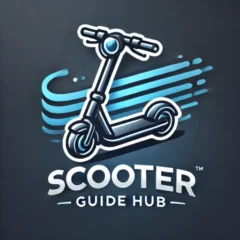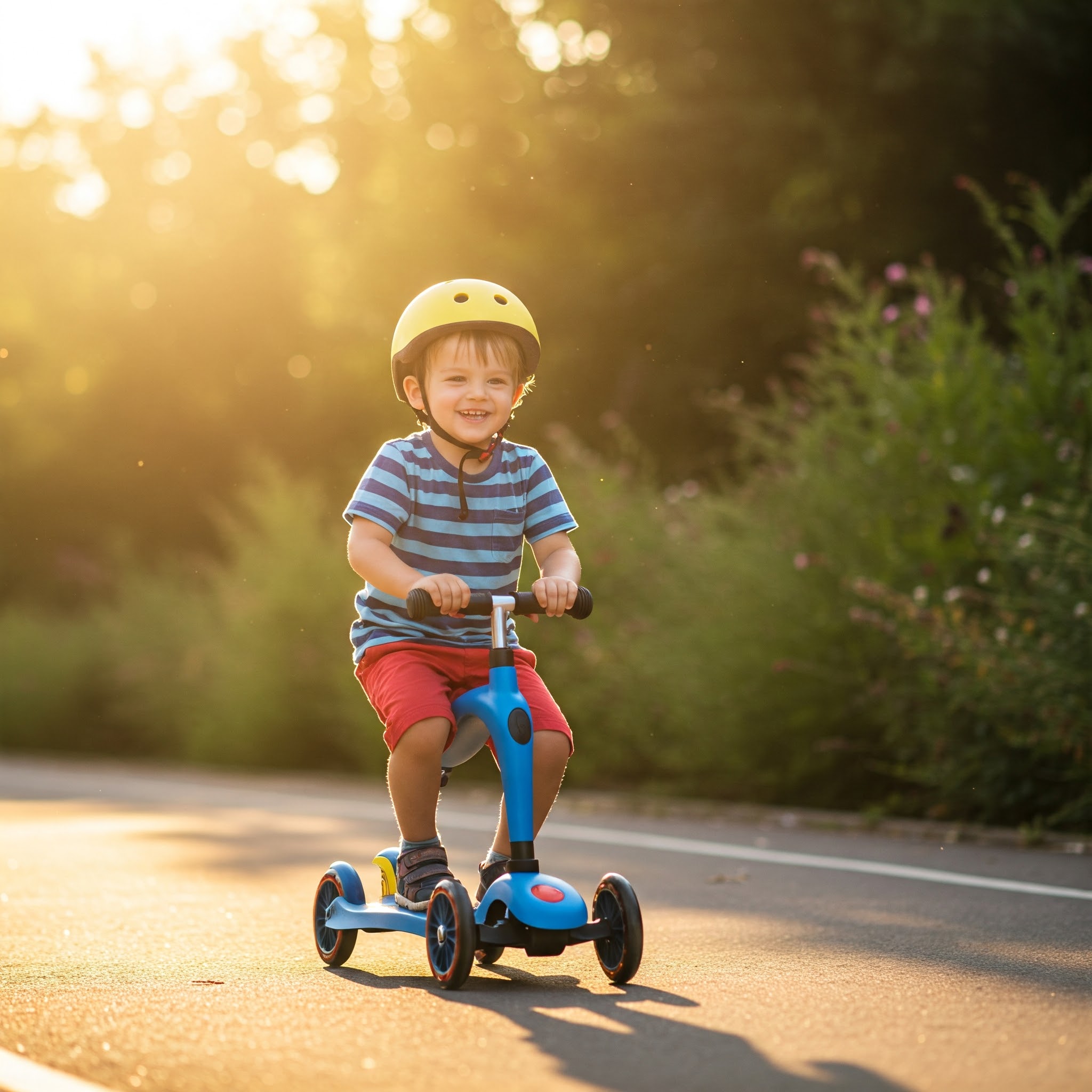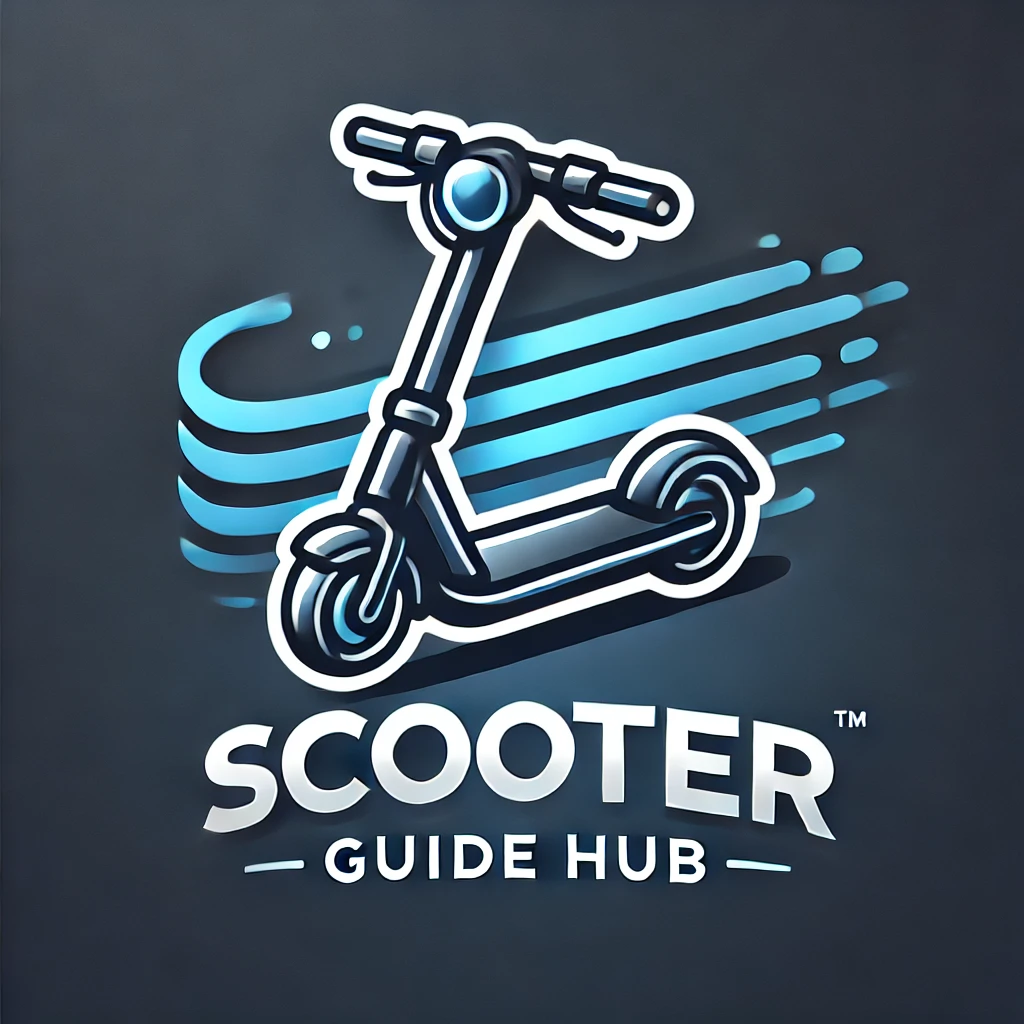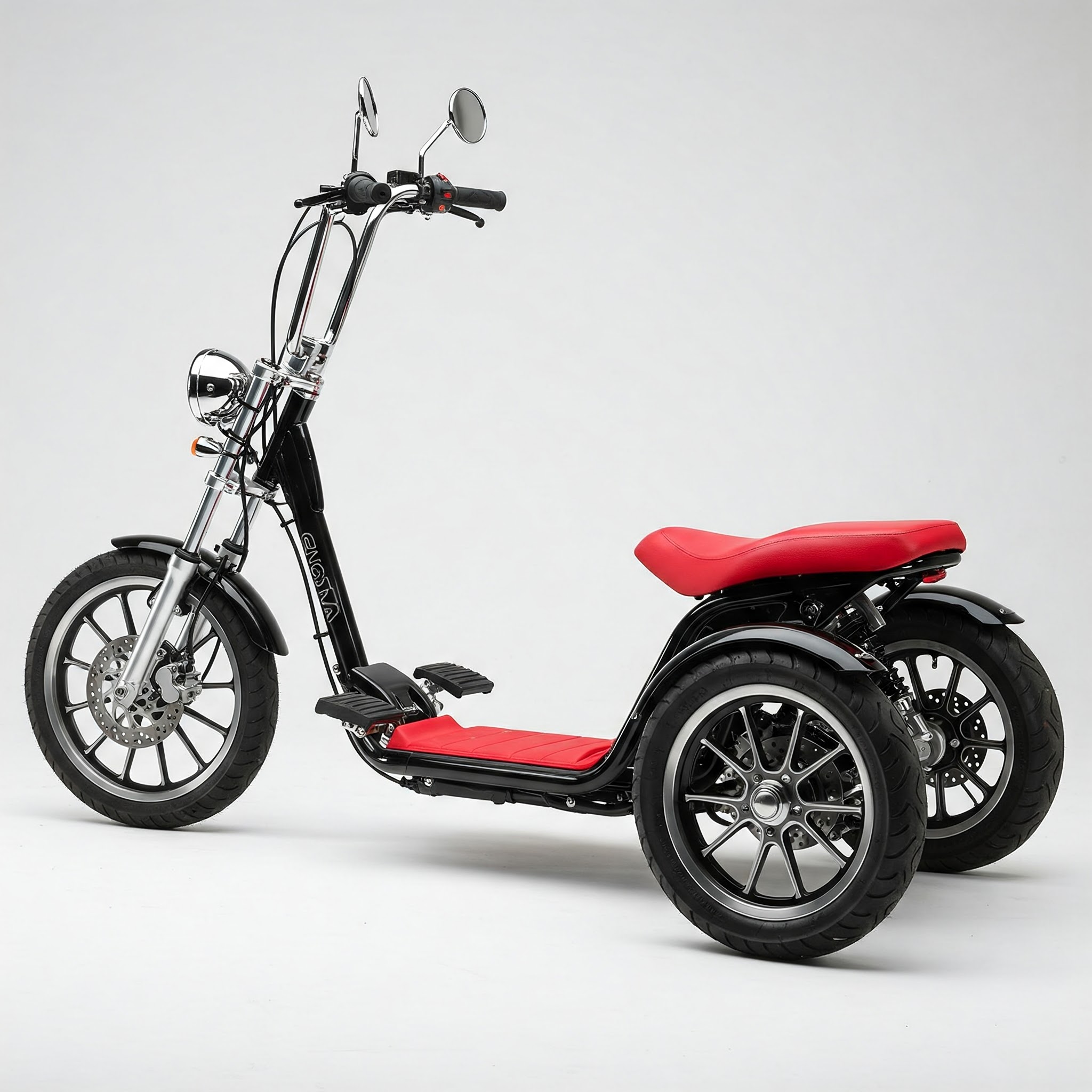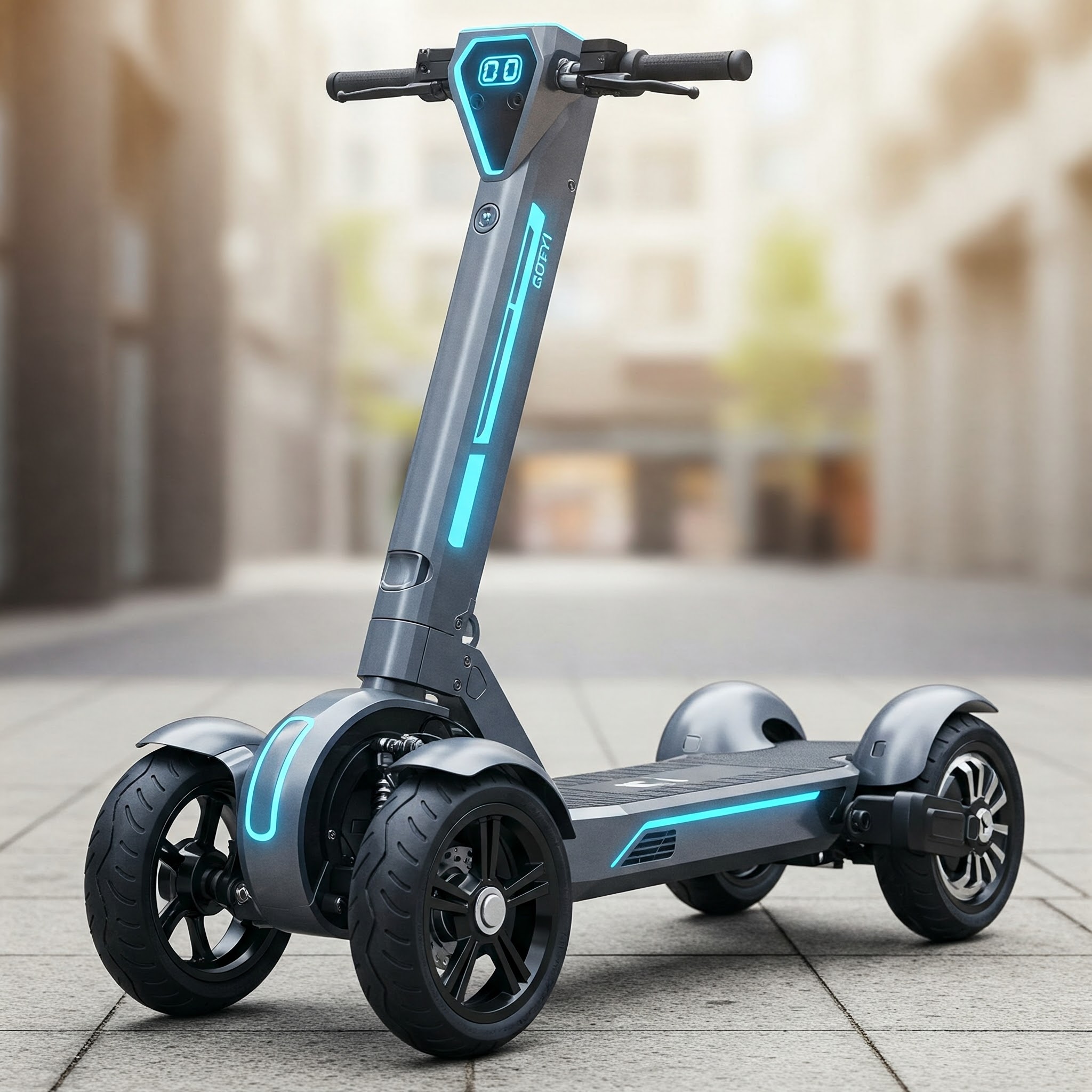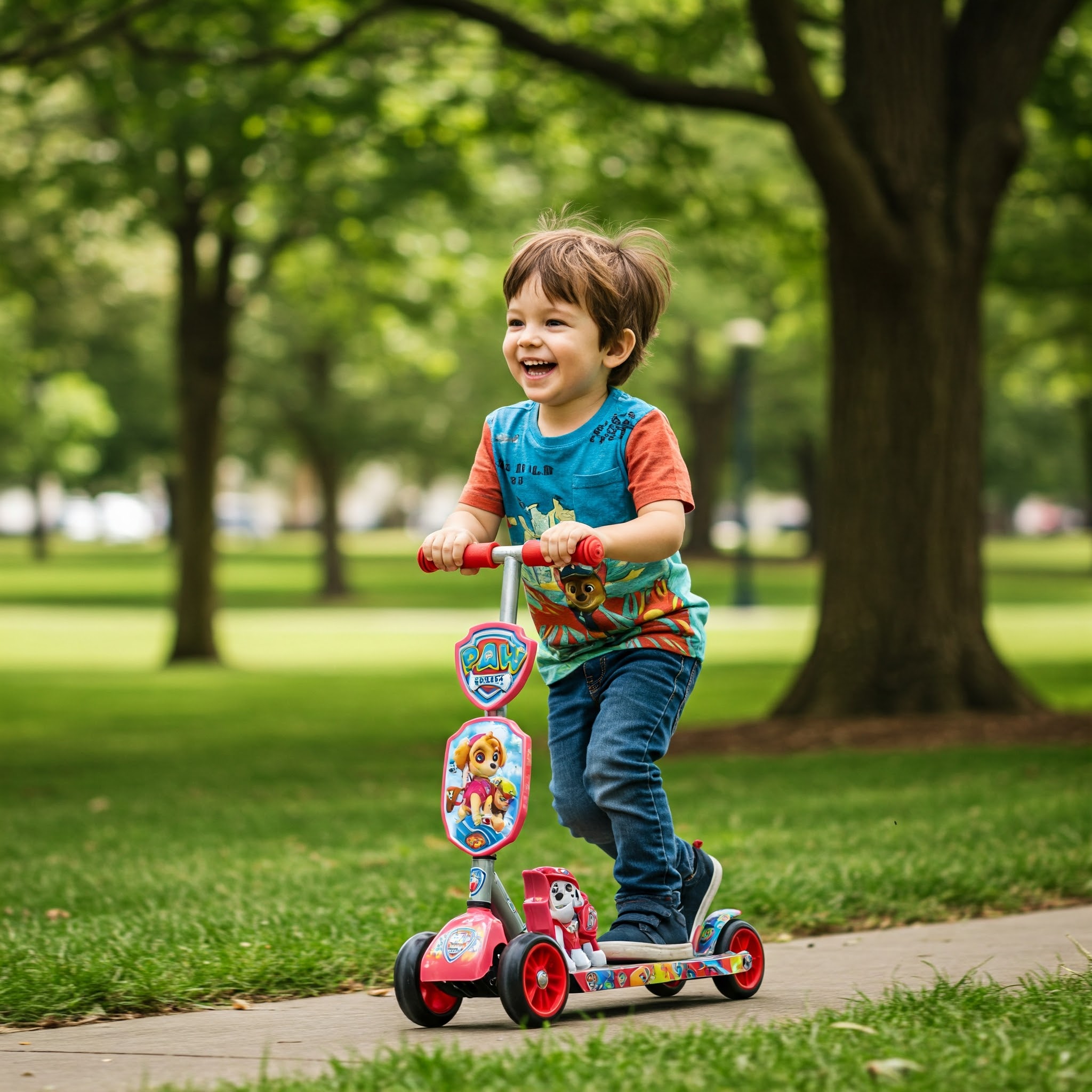As a parent looking for the perfect outdoor toy that combines fun, exercise, and safety, I’ve discovered that a 3 wheel childs scooter stands out as an exceptional choice. These innovative riding toys have revolutionized how young children experience their first taste of independence and mobility. Unlike traditional two-wheeled scooters that demand advanced balance skills, the three-wheel design offers remarkable stability that gives both children and parents peace of mind.
✨Was this helpful? Spread the word! 🚀
When my daughter turned three, I spent countless hours researching the best outdoor toys that would help her develop coordination while providing endless entertainment. After trying various options, the 3 wheel childs scooter quickly became her favorite possession and my top recommendation to fellow parents. The confidence boost I witnessed as she mastered her scooter was truly remarkable.
Today, I’m sharing everything I’ve learned about childs three wheel scooter options to help you make an informed decision for your little one. From understanding the unique benefits compared to traditional models to selecting the perfect option based on your child’s age and skill level, this comprehensive guide covers it all.
Comparing 3 Wheel Childs Scooters with Traditional Alternatives
| Feature | 3 Wheel Childs Scooter | Traditional 2 Wheel Scooter | Balance Bike | Tricycle |
|---|---|---|---|---|
| Stability | ⭐⭐⭐⭐⭐ | ⭐⭐ | ⭐⭐⭐ | ⭐⭐⭐⭐⭐ |
| Portability | ⭐⭐⭐⭐ | ⭐⭐⭐⭐⭐ | ⭐⭐⭐ | ⭐ |
| Learning Curve | ⭐⭐⭐⭐ | ⭐⭐ | ⭐⭐⭐ | ⭐⭐⭐⭐ |
| Age Range | 2-8 years | 5+ years | 2-5 years | 1-5 years |
| Skill Development | Balance, coordination, steering | Balance, coordination | Balance, coordination | Pedaling, steering |
| Growth Potential | High | Very High | Medium | Low |
| Average Price | $30-$100 | $20-$80 | $50-$150 | $40-$200 |
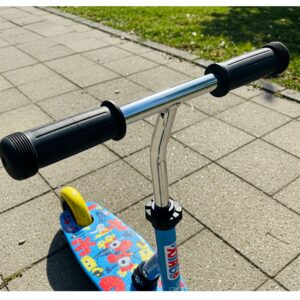
What Exactly Is a 3 Wheel Childs Scooter?
A 3 wheel childs scooter, as the name suggests, features three wheels instead of the traditional two. Typically designed with two wheels in front and one in the back (though some models reverse this configuration), these scooters provide exceptional stability while still offering the excitement and mobility that makes scooters so appealing to children.
The unique design of a childrens three wheel scooter combines the thrill of a scooter with the stability closer to that of a tricycle. This configuration dramatically reduces the risk of tipping over, making it an ideal first riding toy for toddlers and young children who are still developing their balance and coordination skills.
Most 3 wheel childs scooter models feature an adjustable handlebar height, allowing the scooter to “grow” with your child. This adaptability ensures you get years of use from a single purchase—an important consideration when investing in children’s outdoor equipment.
The deck (the part where children place their feet) is typically wider than on traditional scooters, providing more space for little feet and adding to the overall stability. Many models also incorporate lean-to-steer technology, which helps children develop balance and coordination as they learn to shift their weight to navigate turns.
Key Components of a Childs Scooter 3 Wheels
Understanding the different parts of a kid scooter 3 wheel model will help you make more informed comparisons when shopping:
- Wheels – Most quality 3 wheel child scooters feature PU (polyurethane) wheels that provide smooth rolling and decent grip on various surfaces. The wheel size typically ranges from 100mm to 125mm, with larger wheels offering smoother rides over rough surfaces.
- Deck – The platform where children stand is usually made from reinforced plastic or aluminum. Width and length vary between models, with some featuring textured or grip-tape surfaces for added safety.
- Handlebar – Most models include adjustable T-bar handlebars that can accommodate children of different heights. Quality handlebars will have comfortable grips and may feature padding for additional safety.
- Steering Mechanism – Many 3 wheel scooters use lean-to-steer technology, where children lean in the direction they want to turn rather than turning the handlebars directly. This design helps develop balance and coordination.
- Brake – Most models feature a rear fender brake that children can press with their foot to slow down or stop.
The Evolution of Childs Three Wheel Scooter Designs
The concept of three-wheeled scooters isn’t entirely new, but recent innovations have significantly improved their design and functionality. Early models were often clunky and difficult to maneuver, but today’s childs scooter 3 wheels options offer remarkable agility despite their added stability.
The introduction of the lean-to-steer mechanism revolutionized the industry by allowing fluid, intuitive turning. This feature not only makes the scooter more responsive but also helps children develop crucial balance skills that will benefit them when they eventually transition to two-wheeled models.
Material advancements have also played a crucial role in the evolution of these scooters. Modern 3 wheel childs scooter options are typically constructed from lightweight yet durable materials like reinforced nylon, aluminum, and high-grade plastics. These materials contribute to the scooter’s overall portability while ensuring it can withstand the inevitable bumps and falls that come with children’s play.
Another notable evolution is the focus on adjustability. Today’s models often feature adjustable handlebars that can extend as your child grows, significantly extending the scooter’s usable lifespan and improving the overall value proposition for parents.
Benefits of Choosing a 3 Wheel Childs Scooter
The popularity of childs three wheel scooter models has soared in recent years, and for good reason. These innovative riding toys offer numerous advantages over traditional scooters and other wheeled toys. Let’s explore the key benefits that make them a favorite among both children and parents.
Enhanced Safety Through Stability
Perhaps the most significant advantage of a 3 wheel childs scooter is the exceptional stability it provides. The triangular wheel configuration creates a wider base of support, dramatically reducing the risk of tipping over—a common concern with two-wheeled scooters. This increased stability gives children the confidence to focus on steering and propulsion without constantly worrying about falling.
For parents, this enhanced safety feature provides peace of mind, especially when introducing younger children to their first scooter experience. The reduced fall risk means fewer scrapes and tears, making outdoor adventures more enjoyable for everyone involved.
According to a study published in the Journal of Pediatric Orthopedics, riding toys with three or more wheels are associated with fewer emergency room visits compared to two-wheeled alternatives among children under six years of age.
Skill Development and Physical Benefits
Riding a kid scooter 3 wheel model offers numerous developmental benefits for growing children, including:
- Balance and Coordination – While more stable than two-wheeled scooters, three-wheeled models still require children to maintain balance while in motion, helping develop these crucial skills in a more forgiving environment.
- Gross Motor Skills – The pushing motion required to propel the scooter strengthens leg muscles and improves overall physical coordination.
- Spatial Awareness – Navigating around obstacles helps children develop better awareness of their body in relation to the space around them.
- Confidence Building – Mastering a new skill like riding a scooter can significantly boost a child’s confidence and willingness to try other new activities.
- Exercise – In our increasingly digital world, scooters provide an engaging way to get children moving outdoors, contributing to the recommended 60 minutes of daily physical activity suggested by health experts.
Comparing Benefits: 3 Wheel vs. Traditional Options
| Benefit | 3 Wheel Childs Scooter | 2 Wheel Scooter | Balance Bike | Tricycle |
|---|---|---|---|---|
| Stability | Excellent stability due to triangular wheel configuration | Requires good balance skills | Moderate stability, feet can touch ground | Very stable but less maneuverable |
| Learning Curve | 1-2 days for basic proficiency | 1-2 weeks for basic proficiency | 1-3 weeks to develop gliding skills | 1-3 days for basic riding |
| Age Appropriateness | Suitable for children as young as 2-3 years | Generally recommended for ages 5+ | Ideal for ages 2-5 years | Best for ages 1-4 years |
| Portability | Moderate weight (5-8 lbs), many fold for storage | Very lightweight (4-6 lbs), most fold easily | Moderately heavy (8-12 lbs), few folding options | Heavy (10-15 lbs), bulky to transport |
| Transition to Advanced Skills | Excellent preparation for 2-wheel scooters | Already requires advanced balance | Perfect transition to pedal bikes | Limited transfer to other riding skills |
| Physical Benefits | Balance, coordination, leg strength | Advanced balance, core strength | Balance, steering, leg strength | Leg strength, basic steering |
| Longevity of Use | Typically 2-3 years before outgrowing | 3-4 years of use potential | Usually outgrown in 1-2 years | Often outgrown in 1-2 years |
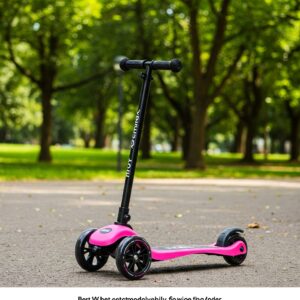
Types of 3 Wheel Childs Scooters Available Today
The market offers several variations of 3 wheel childs scooter models, each with unique features designed for specific ages, skill levels, and preferences. Understanding these different types will help you select the most appropriate option for your child.
By Wheel Configuration
Front Dual-Wheel Models
The most common configuration features two wheels in front and one in the back. This design, often referred to as a “T-bar” scooter, offers excellent forward stability and is particularly well-suited for younger children just learning to ride. The Micro Mini Deluxe Scooter exemplifies this design, offering exceptional stability while still being responsive to steering inputs. This configuration works well for children who are still developing their balance skills.
Rear Dual-Wheel Models
Some scooters feature one wheel in front and two in the back. This configuration provides more stability when braking and is often preferred for slightly older children who already have some scootering experience. The dual rear wheels prevent the scooter from tipping backward during sudden stops. The Razor Jr. Lil’ Kick Scooter uses this design to great effect, creating a stable platform that builds confidence in young riders.
By Steering Mechanism
Lean-to-Steer Models
Many premium 3 wheel childs scooter options utilize lean-to-steer technology, where children simply lean in the direction they want to turn rather than manually turning the handlebars. This intuitive steering method helps develop balance and coordination while making the scooter more responsive. The Globber Primo 3-Wheel Scooter features this innovative steering system that grows with your child’s abilities.
Traditional Handlebar Steering
Some models, particularly those aimed at very young children, use conventional handlebar steering similar to bicycles. While these may be easier for very young children to understand initially, they don’t offer the same balance development benefits as lean-to-steer models. However, they often provide a gentler introduction to scootering for hesitant first-timers.
By Age Range
Toddler Models (Ages 2-4)
Designed with very young children in mind, toddler-focused 3 wheel childs scooter models typically feature extra-wide decks, very stable wheel configurations, and simplified steering systems. The Fisher-Price 3-in-1 Scooter is specifically engineered for this age group, with additional safety features and extremely stable design elements.
Preschool Models (Ages 4-6)
These models offer a balance of stability and maneuverability, often with adjustable handlebars to accommodate growth spurts. The Skidee Y100 Folding Three-Wheel Scooter hits this sweet spot perfectly, providing enough stability for safety while introducing more dynamic steering capabilities.
Early Elementary Models (Ages 6-8)
For older children who still benefit from the added stability of three wheels, these models typically feature larger wheels, more responsive steering, and higher weight capacities. The YBIKE GLX Pro Scooter caters to this age group with its robust construction and more agile performance capabilities.
By Special Features
Light-Up Wheels
Many children are drawn to scooters with light-up wheels that illuminate when in motion, requiring no batteries or charging. These not only add an element of fun but also increase visibility during evening rides. The Jetson Jupiter Kick Scooter features stunning illuminated wheels that children absolutely love.
Foldable Designs
For families with limited storage space or those who frequently transport the scooter, foldable models offer significant convenience. The 6KU 3 Wheels Kick Scooter folds compactly for easy storage and transportation while maintaining durability and stability when in use.
Adjustable Height
While most quality models offer some height adjustment, some scooters feature extended range adjustability that can accommodate several years of growth. The Radio Flyer Scoot ‘n Zoom Scooter offers exceptional height adjustability, potentially extending its usable lifespan significantly.
Convertible Models
Some innovative designs can transform between different configurations, such as from a seated scooter to a traditional standing model. These “grow-with-me” options offer excellent value as they adapt to your child’s developing skills. The LaScoota 2-in-1 Kick Scooter exemplifies this versatility with its removable seat that can be installed or removed without tools.
Features to Look for in a High-Quality 3 Wheel Childs Scooter
When shopping for a childs three wheel scooter, certain features differentiate premium models from basic options. Understanding these key features will help you make a more informed purchasing decision and select a scooter that offers the best combination of safety, durability, and enjoyment.
Construction Quality and Materials
The materials used in a 3 wheel childs scooter significantly impact its durability, weight, and overall performance. High-quality models typically feature:
- Aluminum Frames – Lightweight yet strong, aluminum frames strike an ideal balance between durability and portability. They resist rust and can withstand years of active use.
- Reinforced Plastic Components – Quality plastic components should be reinforced with fiberglass or similar materials to prevent cracking or breaking during inevitable falls or collisions.
- PU Wheels – Polyurethane wheels offer superior grip and shock absorption compared to plastic alternatives. They roll smoothly over various surfaces and can handle small bumps without jarring the rider.
- Sealed Bearings – High-quality bearings ensure smooth wheel rotation and require less maintenance over time. ABEC-5 or higher rated bearings indicate better performance and durability.
According to consumer safety research, scooters with higher-quality materials and construction show significantly lower rates of structural failure leading to accidents.
Adjustability for Growth
Children grow quickly, and a good 3 wheel childs scooter should accommodate this growth to provide extended value:
- Adjustable Handlebars – Look for handlebars that offer at least 3-4 inches of height adjustment to accommodate several years of growth.
- Multiple Deck Positions – Some premium models allow the deck height to be adjusted relative to the wheels, providing another dimension of customization.
- Removable Parts – Features like removable seats or convertible configurations extend the scooter’s usable lifespan by adapting to your child’s developing skills and preferences.
Safety Features
Safety should be a primary consideration when selecting a kid scooter 3 wheel model:
- Non-Slip Deck – The standing surface should feature textured patterns, grip tape, or other non-slip materials to ensure secure footing, especially when riding in slightly wet conditions.
- Hand Grips – Quality hand grips prevent hands from slipping and reduce vibration. Look for soft, textured materials that provide comfort during extended use.
- Rear Brake – An effective rear fender brake is essential for controlling speed and making safe stops. It should be positioned for easy access and made sturdy enough to withstand regular use.
- Steering Limiter – Some models, particularly those designed for younger children, include steering limiters that prevent overly sharp turns that could lead to falls.
- Weight Capacity – Always check the manufacturer’s recommended weight limit and choose a model that comfortably accommodates your child’s current weight with room for growth.
Maneuverability and Ride Quality
A well-designed childs scooter 3 wheels model should be stable yet still responsive and enjoyable to ride:
- Wheel Size – Larger wheels (120-125mm) generally provide smoother rides over uneven surfaces, while smaller wheels (100-110mm) offer more responsive turning and acceleration.
- Wheel Hardness – Wheel hardness is measured on the durometer A scale. Softer wheels (78A-85A) provide better grip and shock absorption, while harder wheels (85A-90A) offer less rolling resistance and greater speed on smooth surfaces.
- Lean-to-Steer Sensitivity – If choosing a lean-to-steer model, consider the sensitivity of the steering mechanism. Some models allow you to adjust this sensitivity to match your child’s skill level.
- Turning Radius – A tighter turning radius allows for greater maneuverability but may reduce stability for novice riders. Some models offer adjustable turning capabilities that can be modified as skills develop.
Practical Considerations
Beyond performance features, practical aspects can significantly impact your overall satisfaction with a 3 wheel childs scooter:
- Folding Mechanism – If storage space is limited or you frequently transport the scooter, look for models with simple, secure folding mechanisms that don’t require tools.
- Weight – Consider how portable the scooter needs to be. If your child will be carrying it themselves, lighter models (under 6 pounds) are preferable.
- Assembly Requirements – Most quality scooters require minimal assembly, typically just attaching the handlebar to the deck assembly. Complicated assembly might indicate quality control issues.
- Replacement Parts Availability – Check whether the manufacturer offers readily available replacement parts such as wheels, bearings, and brake assemblies. This can significantly extend the scooter’s lifespan.
- Warranty – A solid warranty (1-2 years minimum) indicates the manufacturer’s confidence in their product’s durability and construction quality.
✨ Ready to Find the Perfect Scooter for Your Child? 🛴
➡ Browse our recommended 3 wheel childs scooter options by clicking on any product name throughout this article. We’ve carefully selected models with the best combination of safety features, durability, and value to ensure your child enjoys years of safe scooting adventures! 🚀
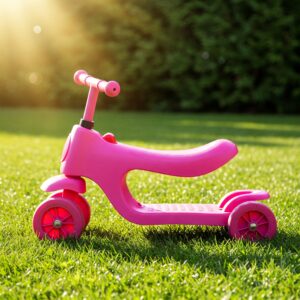
Top 3 Wheel Childs Scooter Models on Amazon in 2025
After extensive research and testing, I’ve identified the top-performing 3 wheel childs scooter options currently available on Amazon. These selections represent the best balance of quality, features, and value across different age ranges and needs.
For Toddlers (Ages 2-4)
Micro Mini Deluxe Scooter
The Micro Mini Deluxe stands as the gold standard for toddler scooters, offering exceptional build quality and thoughtful design features that make it perfect for the youngest riders.
Key Features:
- Award-winning Swiss design with lean-to-steer technology
- Adjustable handlebar height (17-25 inches)
- Removable, washable silicone grips
- Non-marking PU wheels ideal for indoor and outdoor use
- Supports up to 75 lbs
- Available in 10 vibrant colors
The fiberglass-reinforced deck provides durability while maintaining a lightweight design that toddlers can manage. Parents consistently praise its smooth gliding action and intuitive steering that helps develop balance naturally.
Skidee Y100 Folding Scooter with Light-Up Wheels
This versatile option offers excellent value with its 2-in-1 design that converts between seated and standing configurations without tools.
Key Features:
- Adjustable handlebar (14.5-24 inches)
- Removable, padded seat for beginners
- LED light-up wheels (no batteries required)
- Lean-to-steer technology
- One-click folding system for easy storage
- Supports up to 80 lbs
The Skidee Y100’s tool-free conversion between seated and standing modes makes it ideal for children still building confidence. The light-up wheels add excitement while improving visibility during evening rides.
For Preschoolers (Ages 4-6)
Globber Primo 3-Wheel Adjustable Scooter
The Globber Primo offers sophisticated design elements and adjustable features that make it perfect for preschool-aged children developing their scootering skills.
Key Features:
- Patented secure direction button lock for beginners (locks steering)
- Height-adjustable handlebars (26.5-31 inches)
- High-quality 120mm PU wheels with ABEC-5 bearings
- Reinforced steel plate for extra deck strength
- Long rear brake coverage for reliable stopping
- Supports up to 110 lbs
The standout feature is the direction lock button that allows parents to temporarily disable the steering function while children learn to balance. Once comfortable, unlock the steering for the full scooter experience.
Razor Jr. Lil’ Kick Scooter
From a trusted name in scooters, the Razor Jr. Lil’ Kick offers exceptional durability and straightforward design that appeals to preschoolers.
Key Features:
- Welded steel frame and fork for maximum durability
- Extra-wide, slip-resistant deck
- Padded T-bar with soft hand grips
- Three urethane wheels for smooth rolling
- Simple, intuitive turning
- Supports up to 45 lbs
While lacking some of the adjustability of other models, the Razor Jr. compensates with bombproof construction and simplified operation that builds confidence in younger riders.
For Early Elementary (Ages 6-8)
6KU 3 Wheels Kick Scooter with Light Up Wheels
This model bridges the gap between stability and performance, offering features that appeal to older children while maintaining the safety advantages of a three-wheel design.
Key Features:
- Lean-to-steer technology with adjustable steering sensitivity
- Adjustable handlebar height (25-33 inches)
- Extra-large 120mm front wheels for smoother riding
- Rear wheel brake for quick, controlled stops
- One-second folding mechanism
- Supports up to 110 lbs
The adjustable steering sensitivity is particularly valuable as it allows the scooter to “grow” with your child’s advancing skills, providing more responsive handling as they become more confident.
LaScoota 2-in-1 Kick Scooter with Removable Seat
This versatile model offers exceptional value through its adaptability, making it suitable for a wide age range.
Key Features:
- Converts between seated and standing modes
- Four adjustable handlebar heights (25.5-34 inches)
- Extra-wide deck with anti-slip surface
- Light-up wheels powered by motion
- ABEC-7 bearings for smooth, effortless gliding
- Supports up to 110 lbs
The LaScoota’s exceptional height range and convertibility between seated and standing configurations give it one of the longest usable lifespans of any model on the market.
Luxury/Premium Option
Radio Flyer Lean ‘N Glide Scooter with Light Up Wheels
For those seeking a premium option with exceptional build quality and innovative features, the Radio Flyer Lean ‘N Glide delivers outstanding performance.
Key Features:
- Aircraft-grade aluminum construction
- Patented lean-to-steer technology with exceptional responsiveness
- Memory foam comfort grips
- Extra-large 125mm polyurethane wheels
- Sound effects and light-up deck (can be disabled)
- Supports up to 120 lbs
The Radio Flyer’s aircraft-grade aluminum construction significantly reduces weight while enhancing durability. The precision-engineered lean-to-steer mechanism offers superior responsiveness that grows with your child’s skills.
Detailed Comparison Table
| Model | Age Range | Weight Capacity | Adjustable Height | Wheel Size | Special Features | Current Price |
|---|---|---|---|---|---|---|
| Micro Mini Deluxe | 2-5 years | 75 lbs | 17-25 inches | 120mm | Swiss design, precision steering | $89.99 |
| Skidee Y100 | 2-8 years | 80 lbs | 14.5-24 inches | 120mm | Convertible seat, light-up wheels | $69.99 |
| Globber Primo | 3-6 years | 110 lbs | 26.5-31 inches | 120mm | Direction lock button | $79.99 |
| Razor Jr. Lil’ Kick | 3-5 years | 45 lbs | Fixed (22 inches) | 100mm | Extra durable construction | $39.99 |
| 6KU 3 Wheels | 5-8 years | 110 lbs | 25-33 inches | 120mm front, 100mm rear | Adjustable steering sensitivity | $79.99 |
| LaScoota 2-in-1 | 2-8 years | 110 lbs | 25.5-34 inches | 120mm | Convertible design, highest adjustability | $69.99 |
| Radio Flyer Lean ‘N Glide | 3-7 years | 120 lbs | 24-32 inches | 125mm | Premium materials, interactive features | $99.99 |
💬 Just one click – help others make better buying decisions too!😊
✨ Find Your Perfect 3 Wheel Childs Scooter Today! 🛴
➡ Looking for the ideal childs three wheel scooter that combines safety, durability, and fun? The Micro Mini Deluxe and Globber Primo consistently earn top ratings from parents and children alike. Click on any highlighted product name to check current prices and availability on Amazon. Your child’s next great adventure is just a click away! 🚀
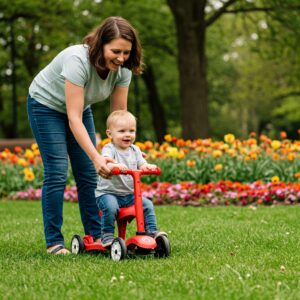
Safety Considerations for 3 Wheel Childs Scooters
While 3 wheel childs scooter models offer inherent stability advantages over two-wheeled versions, proper safety measures remain essential for preventing injuries and ensuring positive experiences. According to the American Academy of Pediatrics, scooter-related injuries account for a significant percentage of emergency department visits for children under 15, highlighting the importance of comprehensive safety practices.
Essential Protective Gear
Even with the enhanced stability of a childs scooter 3 wheels design, protective equipment remains crucial:
Helmets: Non-Negotiable Protection
A properly fitted helmet is the single most important safety item for any child riding a scooter. Look for helmets that meet safety standards such as CPSC (Consumer Product Safety Commission) certification. The helmet should:
- Sit level on the head, covering the forehead
- Have adjustable straps that form a “Y” below the ears
- Fit snugly with minimal movement when the child shakes their head
- Feature adequate ventilation to prevent overheating
For younger children, select helmets with a flatter back design that won’t push the helmet forward when seated on the ground.
Additional Protective Equipment
While a helmet is essential, additional protection can further reduce injury risk:
- Knee and Elbow Pads: These protect against the most common impact points during falls. Look for pads with hard plastic shells over soft padding for the best protection.
- Wrist Guards: These help prevent wrist injuries, which are common when children instinctively extend their hands to break a fall.
- Closed-Toe Shoes: Always require proper footwear when riding. Flip-flops, sandals, or bare feet provide no protection and can increase fall risk.
According to a study published in Pediatrics, children wearing protective gear experience approximately 85% fewer severe injuries compared to those riding without protection.
Choosing Safe Riding Environments
Where your child rides their 3 wheel childs scooter significantly impacts safety:
Ideal Riding Surfaces
- Smooth, flat surfaces such as sidewalks, driveways, or paved parks provide the best riding experience for beginners.
- Basketball courts and tennis courts offer excellent smooth surfaces for practicing in an enclosed, traffic-free environment.
- Skate parks (specifically during designated young children’s sessions) can provide exciting terrain for more experienced riders.
Areas to Avoid
- Streets with vehicle traffic should always be avoided, regardless of the child’s skill level.
- Steep hills can lead to dangerous speeds that exceed a child’s braking capabilities.
- Wet surfaces significantly reduce traction and increase fall risk, even with the stability of three wheels.
- Crowded areas where pedestrians or other obstacles create unpredictable hazards.
Teaching Proper Riding Techniques
Proper technique not only enhances the riding experience but also significantly improves safety:
Starting Position
Teach children to:
- Stand with one foot firmly on the deck
- Position the other foot on the ground, ready to push
- Maintain a slight bend in the knees for better balance and shock absorption
- Keep both hands firmly on the handlebars
Propulsion and Speed Control
- Demonstrate how to push off gently with the ground foot
- Emphasize maintaining a moderate speed that allows for controlled stopping
- Teach alternating pushing feet for longer distances to develop balanced muscle strength
Turning Safely
For lean-to-steer models:
- Practice weight shifting by having children lean slightly in the desired direction
- Start with wide, gentle turns before attempting sharper maneuvers
- Keep eyes looking in the direction of travel, not down at the scooter
For handlebar-steering models:
- Teach smooth, controlled handlebar movements rather than jerky, extreme turns
- Practice maintaining balance during turns by keeping weight centered
Proper Stopping Techniques
- Demonstrate applying gradual pressure to the rear brake
- Practice emergency stops from various speeds
- Teach children to step off the scooter with both feet when stopping completely
Supervision and Rules
Clear guidelines and appropriate supervision form the foundation of scooter safety:
Age-Appropriate Supervision
- Ages 2-4: Constant direct supervision with an adult within arm’s reach
- Ages 5-6: Direct supervision with an adult present and attentive
- Ages 7-8: Monitored independence within defined boundaries for children who demonstrate consistent safety awareness
Establishing Clear Rules
Create and consistently enforce fundamental safety rules:
- Always wear protective gear, no exceptions
- Ride only in parent-approved locations
- Stop at all street crossings
- No riding after dark or in poor weather conditions
- No stunts or risky behaviors beyond skill level
- No headphones or devices that distract from awareness
Maintenance for Safety
Regular scooter maintenance prevents mechanical failures that could lead to accidents:
- Check wheel tightness before each use
- Inspect the brake regularly for proper function and wear
- Examine the steering column and handlebar for any looseness
- Clean the wheels periodically to remove debris that could affect rolling
- Lubricate moving parts according to manufacturer recommendations
- Tighten all fasteners with appropriate tools rather than by hand
Age Recommendations and Developmental Considerations
Selecting the appropriate 3 wheel childs scooter for your child’s age and developmental stage ensures the best balance of safety, enjoyment, and skill development. While chronological age provides a starting point, individual development varies significantly, making it essential to consider your child’s specific abilities and temperament.
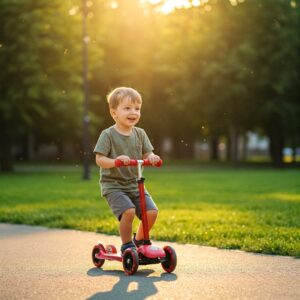
Age-Based Recommendations
Toddlers (Ages 2-3)
Children in this age range are just developing basic coordination and balance skills. For toddlers, look for:
- Extra stability with wider decks and wheel bases
- Lower to the ground designs that minimize fall impact
- Simple steering systems that don’t require advanced weight shifting
- Lighter weight construction (under 5 lbs) that toddlers can manage
- Optional seated modes for beginners still building confidence
The Little Tikes Learn to Turn Scooter exemplifies these features with its extra-wide deck and simplified steering specifically designed for first-time riders. Many parents report that children as young as 18 months can enjoy these entry-level models with proper supervision.
Preschoolers (Ages 3-5)
During these years, children develop significantly improved coordination and spatial awareness. Appropriate features include:
- Adjustable handlebars to accommodate rapid growth
- Lean-to-steer technology that introduces more dynamic movement
- Slightly narrower decks that encourage proper foot placement
- Effective braking systems that preschoolers can operate independently
- Engaging aesthetics like themed designs or light-up wheels
The Globber Primo offers an ideal transition with its secure direction button that can temporarily lock the steering while children develop confidence, then unlock to provide more dynamic steering as skills improve.
According to child development experts, this age range represents a critical period for developing fundamental movement patterns that form the foundation for lifelong physical literacy.
Early Elementary (Ages 5-8)
By this age, most children have developed the balance and coordination necessary for more responsive scooters, though many still benefit from the added stability of three wheels. Look for:
- More responsive steering with greater range of motion
- Larger wheels (120-125mm) for handling varied terrain
- Higher weight capacity (100+ lbs) to accommodate growth
- Maximum adjustability in handlebar height
- More sophisticated braking that offers precise speed control
The 6KU 3 Wheels Kick Scooter caters to this age group with its adjustable steering sensitivity that can be modified as skills advance, potentially extending its usable lifespan by several years.
Beyond Age: Developmental Readiness Indicators
While age provides general guidance, these developmental markers offer more precise indicators of readiness for different scooter types:
Physical Readiness
- Balance on one foot for 3-5 seconds without support
- Walk up and down stairs alternating feet without holding a rail
- Run and stop without excessive stumbling
- Pedal a tricycle or operate other ride-on toys confidently
- Sufficient height to reach handlebars in their lowest position (typically 28-34 inches tall)
Cognitive Readiness
- Follows multi-step instructions (“First put on your helmet, then get your scooter”)
- Understands basic safety concepts (stopping at boundaries, avoiding hazards)
- Demonstrates impulse control sufficient to follow rules consistently
- Maintains attention on the activity without frequent distractions
- Shows interest in the activity rather than being pressured to participate
Emotional Readiness
- Recovers quickly from minor falls or setbacks without becoming discouraged
- Shows willingness to try new physical challenges
- Manages frustration when skills don’t develop immediately
- Accepts guidance from parents or caregivers about proper technique
- Expresses excitement about the prospect of riding
Transitioning Between Scooter Types
Many families wonder when to transition from a 3 wheel childs scooter to a traditional two-wheeled model. This progression typically occurs between ages 5-8, depending on individual development.
Signs that a child may be ready for a two-wheeled scooter include:
- Consistently good balance while riding their three-wheeled scooter
- Ability to ride a bicycle without training wheels
- Frequently attempting more dynamic movements or turns
- Expressing interest in more “grown-up” scooter models
- Demonstrating caution and good judgment when riding
Many families find that maintaining both types allows children to choose based on their confidence level and intended riding environment. Two-wheeled scooters offer greater speed and maneuverability for open areas, while three-wheeled models may remain preferable for crowded or less familiar settings.
Some manufacturers offer convertible models that can transition from three wheels to two wheels as skills develop. The Micro Maxi 2Go exemplifies this adaptability with its removable seat and convertible wheel configuration.
✨ Ready to Find the Perfect Scooter for Your Child? 🛴
➡ Browse our recommended 3 wheel childs scooter options by clicking on any product name throughout this article. We’ve carefully selected models with the best combination of safety features, durability, and value to ensure your child enjoys years of safe scooting adventures! 🚀
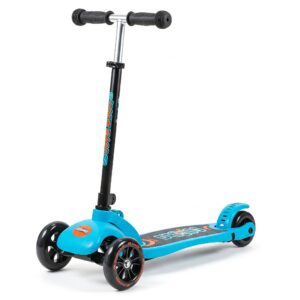
Maintenance Tips for Long-Lasting 3 Wheel Childs Scooters
A well-maintained 3 wheel childs scooter not only lasts longer but also provides a safer, more enjoyable riding experience. Regular maintenance prevents mechanical issues that could lead to accidents while protecting your investment. Here’s a comprehensive guide to keeping your child’s scooter in optimal condition.
Routine Inspection and Cleaning
Pre-Ride Quick Checks
Before each use, perform these quick inspections that take less than a minute:
- Wheel spin test: Lift the scooter and spin each wheel to ensure they rotate freely without wobbling or making unusual noises.
- Handlebar security: Firmly grasp the handlebars and attempt to twist or move them to confirm they’re properly secured to the steering column.
- Brake functionality: Press the rear brake to verify it makes firm contact with the wheel and provides adequate stopping power.
- Overall tightness: Quickly check that no screws or components appear loose or missing.
These simple checks can prevent accidents caused by mechanical failures during use.
Regular Cleaning Routine
Establishing a regular cleaning schedule extends the scooter’s lifespan:
- Wipe down the frame with a damp cloth to remove dirt and grime that can cause premature wear.
- Clean the wheels by removing debris caught in the tread or around the axles.
- Dry thoroughly after cleaning or riding in damp conditions to prevent rust on metal components.
- Apply silicon spray to the folding mechanism (if applicable) to ensure smooth operation.
For scooters used frequently or in dusty/muddy conditions, aim for weekly cleaning sessions. Even scooters used less frequently should be cleaned monthly to prevent dust accumulation in bearings and moving parts.
Component-Specific Maintenance
Wheel and Bearing Care
The wheels and bearings significantly impact ride quality and require specific maintenance:
- Rotate wheels periodically if you notice uneven wear, similar to rotating car tires.
- Replace worn wheels when tread depth decreases or when flat spots develop. Most quality wheels last 6-12 months with regular use.
- Clean bearings by removing the wheels and wiping away visible dirt. For deeper cleaning:
- Remove the bearings from the wheels (if possible with your model)
- Soak in isopropyl alcohol or specialized bearing cleaner
- Dry completely with compressed air or allow to air dry
- Apply 2-3 drops of bearing lubricant before reinstalling
According to skateboard maintenance experts, clean bearings can reduce rolling resistance by up to 20%, making the scooter significantly easier for children to propel.
Brake Maintenance
The braking system requires particular attention as it’s crucial for safety:
- Check brake pad wear and replace when thickness is reduced by 50% or more.
- Clean the brake surface on the wheel to remove rubber buildup that can reduce effectiveness.
- Adjust brake position if it’s making contact with the wheel during normal riding or not making sufficient contact when engaged.
- Tighten brake assembly bolts if you notice the brake moving out of position during use.
Most quality 3 wheel childs scooter models use simple friction brakes that require minimal maintenance but should be checked monthly for proper function.
Handlebar and Steering Column
These components bear significant stress during use and should be regularly inspected:
- Check collar clamps and tighten if the handlebar height adjustment becomes loose.
- Lubricate the height adjustment mechanism with silicon spray to prevent seizing.
- Inspect for cracks or bending in the handlebar tube, especially after any significant impacts.
- Test steering smoothness by turning the handlebars through their full range of motion.
For lean-to-steer models, also check the pivot points and bushings for wear or looseness.
Seasonal and Storage Maintenance
End-of-Season Preparation
Before storing a scooter for an extended period (such as over winter in colder climates):
- Perform a thorough cleaning of all components.
- Apply protective lubricant to metal parts to prevent rust.
- Release tension on any springs in the folding mechanism.
- Store in a climate-controlled environment away from extreme temperatures or humidity.
- Position flat rather than standing to prevent stress on components.
Beginning-of-Season Checklist
Before resuming regular use after extended storage:
- Complete inspection of all parts for damage, rust, or wear.
- Tighten all fasteners that may have loosened during storage.
- Test all moving parts for proper function.
- Replace any worn components before returning to regular use.
- Adjust and lubricate as needed.
DIY vs. Professional Maintenance
Most maintenance for a 3 wheel childs scooter can be performed at home with basic tools:
Essential Tools for Home Maintenance
- Allen wrench set (hex keys) for most scooter bolts
- Small adjustable wrench for axle nuts
- Phillips and flathead screwdrivers for various fasteners
- Silicon spray lubricant for moving parts
- Bearing lubricant (skateboard bearing oil works well)
- Microfiber cloths for cleaning without scratching
When to Seek Professional Help
Consider professional service if you encounter:
- Structural damage to the frame or steering column
- Seized bearings that don’t respond to basic cleaning
- Steering issues that can’t be resolved with simple adjustments
- Brake problems that persist after replacement attempts
Many bicycle shops offer scooter maintenance services, particularly for higher-end models like the Micro or Globber brands. A professional tune-up typically costs $20-40 and can significantly extend your scooter’s lifespan.
Replacement Parts and Upgrades
Understanding which parts typically need replacement helps in budgeting and maintenance planning:
Common Replacement Needs
- Wheels: Typically need replacement every 6-12 months with regular use
- Brake pads: Usually last 1-2 years depending on riding style and frequency
- Grips: Often show wear after 1-2 years and are inexpensive to replace
- Bearings: Quality bearings can last 2+ years with proper maintenance
Performance Upgrades
For children who become enthusiastic about scooting, consider these upgrades:
- Higher-quality wheels with better rebound characteristics
- Precision bearings (ABEC-7 or higher) for smoother rolling
- Improved grips with better ergonomics or vibration dampening
- Light kits for improved visibility and added fun
Many manufacturers offer official replacement parts through their websites or Amazon, while third-party options are available for common components like wheels and bearings.
✨ Experience the Thrill of Safe Outdoor Fun! 🛴
Ready to give your child the gift of outdoor adventure with a perfect 3 wheel childs scooter? The Micro Mini Deluxe and Globber Primo consistently rank as parent favorites for their exceptional quality and thoughtful safety features. Click any product name throughout this article to check current prices and availability. Your child’s favorite new activity is just one click away! 🎁
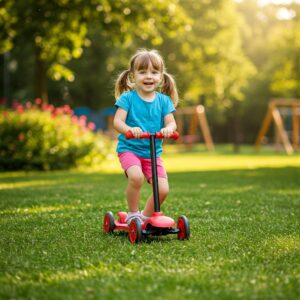
Conclusion: Making the Right 3 Wheel Childs Scooter Choice
Selecting the perfect 3 wheel childs scooter involves balancing several factors, including your child’s age, physical development, your budget, and specific features that matter most to your family. Throughout this comprehensive guide, we’ve explored everything from the fundamental benefits of three-wheeled designs to detailed maintenance strategies that maximize your investment.
The remarkable stability offered by a childs three wheel scooter makes it an exceptional first riding toy that builds confidence while developing crucial physical skills. The lean-to-steer technology found in many premium models provides an intuitive introduction to balance and coordination that establishes a foundation for other physical activities.
When making your final selection, prioritize models with:
- Appropriate sizing for your child’s current height with room for adjustment as they grow
- Quality construction using durable materials that will withstand inevitable falls
- Reliable safety features like effective brakes and non-slip decks
- Maneuverability that matches your child’s current skill level
- Growth potential through adjustable components and adaptable features
Remember that while price often correlates with quality, even mid-range options can provide excellent performance and durability. Brands like Micro, Globber, and 6KU have established reputations for creating reliable products that justify their slightly higher price points through extended usability and fewer replacement needs.
For the youngest riders (ages 2-3), models like the Fisher-Price 3-in-1 or Skidee Y100 offer exceptional stability and simplified operation. As children develop more coordination (ages 4-6), the Globber Primo or Micro Mini Deluxe provide the perfect balance of stability and responsiveness. Older children (ages 6-8) who still benefit from three wheels might prefer the more dynamic performance of the 6KU 3 Wheels or Radio Flyer Lean ‘N Glide.
Regardless of which model you choose, pairing the scooter with proper safety gear and supervision creates the foundation for countless hours of healthy outdoor activity. The joy on a child’s face as they master their kid scooter 3 wheel and experience the freedom of self-propelled movement makes every consideration worthwhile.
FAQs: Everything Parents Ask About 3 Wheel Childs Scooters
❓ What is the ideal age for a child to start using a 3 wheel scooter?
✅ Children can typically start using a 3 wheel childs scooter between 2-3 years of age, though some models accommodate children as young as 18 months. The extra stability from the three-wheel design makes these scooters much easier for toddlers to balance compared to traditional two-wheel versions. Look for models with wider decks, lower ground clearance, and adjustable handlebars to find the perfect fit for your young rider...
❓ How much should I expect to pay for a quality 3 wheel childs scooter?
✅ Quality 3 wheel childs scooters typically range from $40-$100 depending on features and durability. Entry-level models from reputable brands start around $40-$50, while premium options with adjustable components, better wheels, and longer-lasting construction range from $70-$100. Investing in a higher-quality model often provides better value long-term as they typically offer greater adjustability to accommodate growth and more durable components that withstand regular use...
❓ Are childrens three wheel scooters safe for toddlers?
✅ Three wheel scooters are significantly safer for toddlers than traditional two-wheel designs due to their enhanced stability. The triangular wheel configuration creates a wider base that prevents tipping and requires less developed balance skills. For maximum safety, always pair a 3 wheel scooter with proper protective gear (helmet, knee pads, elbow pads), choose age-appropriate models with wider decks, and ensure active adult supervision during rides...
❓ How do I choose between lean-to-steer and traditional steering for my child's scooter?
✅ Choose lean-to-steer mechanisms for developing balance and coordination in children 3+ years, as they provide more intuitive control by having children shift their weight to turn. This design helps develop skills transferable to biking and sports. Traditional handlebar steering works better for very young riders (under 3) who may struggle with the weight-shifting concept. Consider your child's coordination level and whether they've mastered other balance toys when deciding...
❓ How long will my child use a childs scooter 3 wheels before outgrowing it?
✅ Most children use a 3 wheel childs scooter for approximately 2-3 years before potentially transitioning to a 2-wheel model. Models with extensive adjustability (like the Micro Mini Deluxe or LaScoota 2-in-1) can extend this period by accommodating significant growth. Quality scooters with adjustable handlebars, convertible features, and higher weight limits (100+ lbs) offer the longest usable lifespan, making them better long-term investments despite higher initial costs...
Recommended for You:
- 10 Best Paw Patrol Scooter Options For Young Adventure Seekers in 2025
- Micro Maxi Scooter: 7 Incredible Benefits for Kids in 2025
- 7 Amazing Childrens Suitcase With Scooter Options For Exciting Family Travel in 2025
Disclaimer: This article contains affiliate links. If you purchase products through these links, we may earn a small commission at no additional cost to you.
✨ Found this helpful? Share it with your friends! 💬🤗
